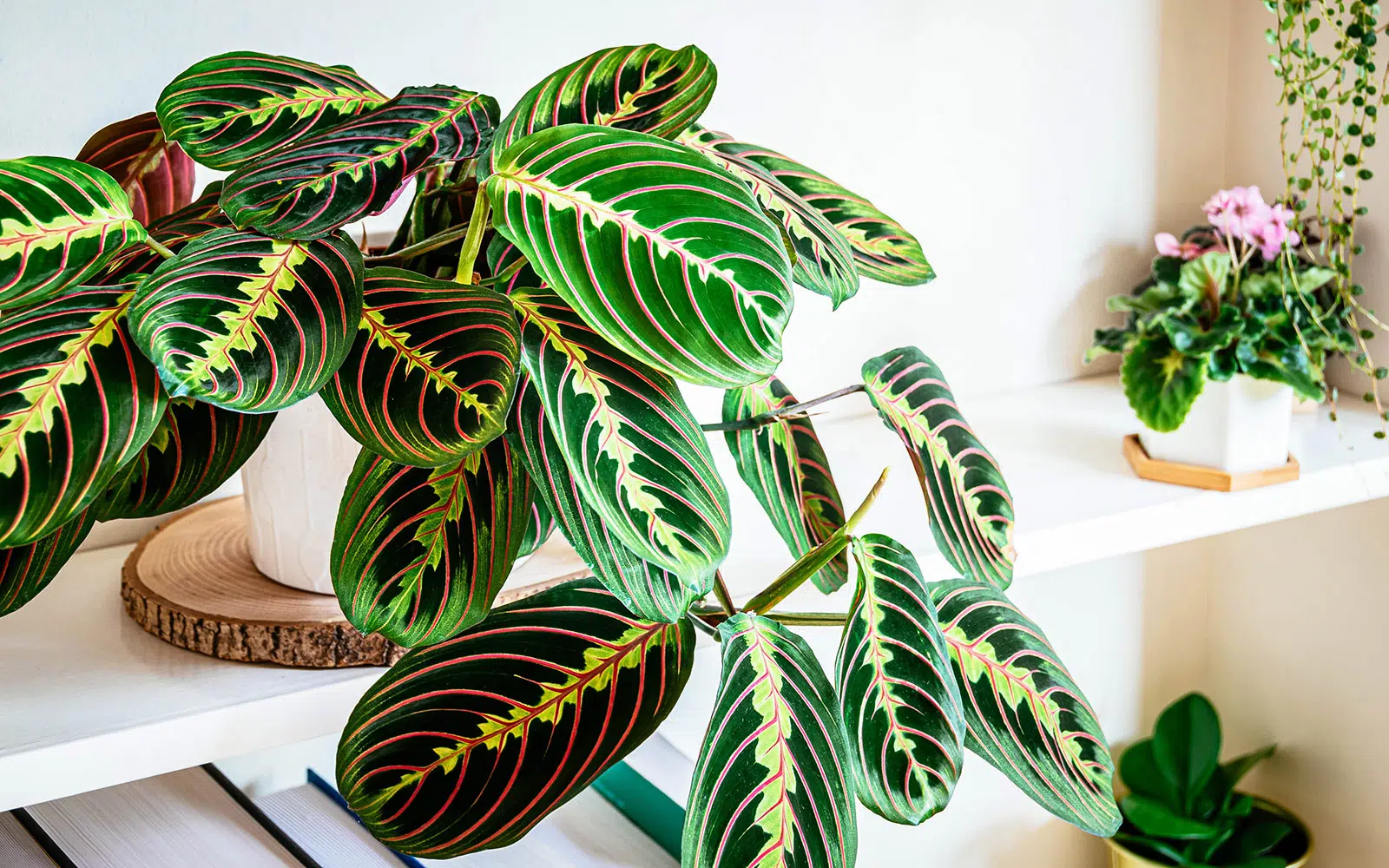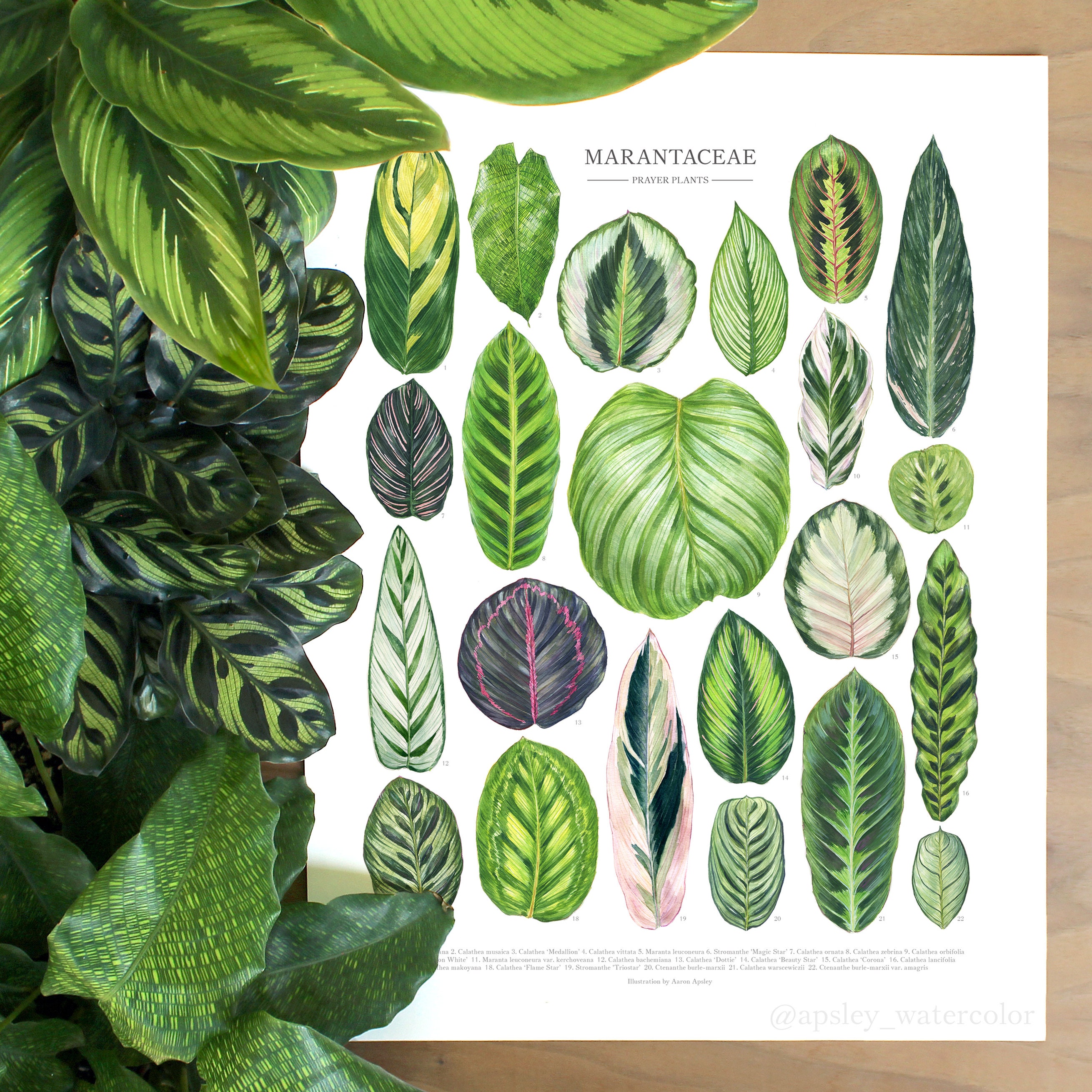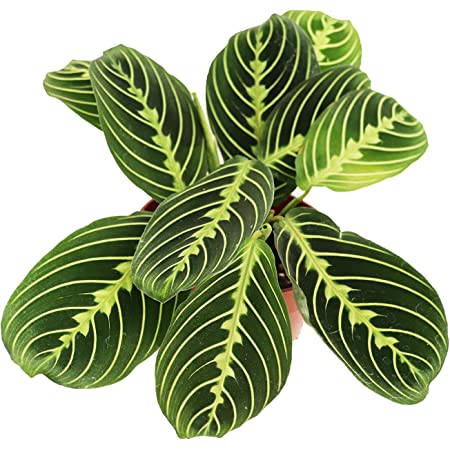
Table of Contents
The Maranta plant
The Maranta originally comes from the middle of South America. Nowadays it is a much sought after plant in many countries. You will find it in many living rooms. And not surprisingly so: it is a real beauty! The leaves of the Maranta are what made the plant so popular. The second part of the name of this plant is “Leuconeura”. This literally means “white vein”. One look at the leaves and you will understand why the Maranta got this name!
So the Maranta is originally a tropical plant. If you bring it into your home you should try to imitate the natural conditions as closely as possible. In this article you can read all about it. If you take good care of it, your Maranta can live up to 30 years!
Another nickname for the Maranta is the “10 commandments plant” or “prayer plant”. The plant opens and closes its leaves in the morning and in the evening, just like someone who prays. Thus, the opening and closing of the leaves occurs to the rhythm of the sun. The leaves are horizontal during the day and vertical at night. Below is a timelapse video of the Maranta in which the movement of the leaves can be clearly seen
This process is called nyctinasty. Several plants, including the Maranta, do this. If the leaves are closed at night, regrowth drops can reach the soil and be absorbed by the roots. Thus, water does not remain on the leaves and the formation of bacteria is prevented.The Maranta falls within the plant family Marantaceae. Other plants within this family, such as the Calathea, also share this special characteristic.
Growth habit of Maranta
This plant is special, that is obvious. Also the growth habit of this plant is different than usual. From under the leaf a kind of tube starts sticking out. This is the new leaf, which is still rolled up nicely. Once the leaf is completely rolled out, it does not take long before a new tube forms underneath it. The Maranta is nice as a small plant, but you can let it grow into a full-fledged hanging plant!
Maranta species
There are many species of Maranta. Most of them still grow in the tropical areas where they originally came from. There are a few that we can find in our garden centers. The Maranta species that are most popular now:
- Maranta Fascinator Tricolor
- Maranta Lemon Lime
- Maranta Kerchoveana
Maranta location & Light
The prayer plant is an easy plant when we talk about pitch. The plant does fine in a shady spot, just like on the ground of a tropical rainforest. A spot in the light is also fine. The only really important thing is that the plant does not catch direct sunlight.
If the plant is not getting enough light you can notice it very well. The leaves do not close completely at night and then do not open during the day. This is a protective reaction of the plant. If this takes too long the Maranta will not survive. Move the plant to a place with more light.
Temperature for Maranta
Although Maranta originates from the tropics, the temperature in the average living room is fine for the praying plant. When it gets too warm in the room, the Maranta will produce less and less leaves. Instead, more and more empty stems will appear. This growth is a response to a lack of moisture in the air, which in turn is a result of higher temperature.
Humidity
The Maranta comes from the tropical rainforests. This means that it does well in conditions with very high humidity. That’s why you often see this plant in a tropical terrarium.Of course, you don’t have to raise the humidity in your living room that much. You can mimic the ideal situation by spraying the plant with a plant sprayer. Make sure that a single mist is already sufficient. Too much water on the leaves can cause rot.
Watering Maranta
The prayer plant has very fine roots that grow shallow and very close together. They are susceptible to root rot, so you have to make sure that excess water can drain away well. You need to water just enough so that the soil does not dry out, but not so much that it becomes too moist. A good measure is a slightly moist soil. Preferably use water that is at room temperature. This allows the plant to adjust to the water. Too cold water can cool the Maranta’s roots and cause stress. This causes leaf drop.
Always try to water the plant in the morning. This gives the plant the whole day to absorb the moisture and reduces the chance of root rot. In addition, the daylight allows excess water on the leaves to evaporate.
It is best to use filtered water. This helps prevent contamination from chemicals such as chlorine or fluoride. If you don’t have a water filter, you can also let the water stand for a few days before giving it to the Maranta.

Soil and ground
You can use normal potting soil for houseplants. The most important thing is that this soil is well-drained. If you use soil that does not allow the water to drain away, mix it with coarse sand or gravel. You can also put a layer of pebbles at the bottom of the pot to make sure water can drain away. Of course in both cases you should have or make a drainage hole in the pot.
The Maranta will do fine this way. The real plant lovers among us can pay attention to the acidity of the soil. The Maranta prefers a soil that is a bit more acidic. Use a peat-based potting mix with a pH of 5.5 to 6.0.
Pruning Maranta
Regular pruning ensures that the plant grows more beautiful and stronger. Fortunately, this is very simple. Cut the stems right above the leaf nodes, the axils, with sharp scissors. The plant’s natural reaction is to send new shoots to the section where it was cut. This will make your plant look fuller. It is best to prune several times a year. The pieces you cut away do not have to be thrown away. You can take cuttings from a Maranta.
Buying a Maranta?
Where can you buy a beautiful Maranta? There are several online retailers. On Bol.com you can find a large number of them. This way you can compare them and make a good choice. Use the button below to go to the current offer:
Common problems
Maranta has yellow/brown spots on the leaf
Leaf spot is one of the most common problems with prayer plants. You can recognize leaf spot by water-soaked spots on the leaves of your plant. These yellow spots spread quickly and eventually turn brown. It occurs because the plant has been watered too often / too much. It can also happen because water has been on the leaves too often, for example by spraying too much or throwing water on the plant when watering. Read the tips on this page about watering the Maranta.
Maranta has critters!
The Maranta is susceptible to a number of common critters such as mealybugs, spider mites and aphids. Bugs can be fatal to your Maranta. If you don’t catch them early enough, they can spread to other plants. It is therefore wise to check them a few times a month. It also happens often that small black flies are present in the soil. These you can fortunately control quite easily. Read more about fighting mourning flies.

This usually happens in the winter. Because the heating is on, the humidity drops. The plant will produce more empty stems and less leaves. Move the plant further away from a heater and spray with room temperature water a few times a week.
The edges of the leaves are turning brown
If the Maranta’s leaves appear to be scorching, it could be because the plant has been standing in direct sunlight. It absolutely cannot stand this!
Summary
| Botanical name | Maranta Leuconeura |
| Also known as | Maranta plant, Ten commandments plant, Prayer plant |
| Place of stand | Indirect light |
| Water | Keep light moist |
| Toxic? | No |
FAQ
What is another name for prayer plant?
prayer plant, (Maranta leuconeura), also called praying hands, flowering plant of the family Marantaceae, native to the New World tropics. It has spreading leaves that turn upward toward evening, seemingly in prayer for evening vespers.
Do Maranta plants like to be misted?
Botanical Classification: Maranta leuconeura The Red Prayer Plant is an easy plant—place it in a sunny spot, keep it’s soil damp, and mist it’s leaves once a week and it will flourish.
Is Maranta same as prayer plant?
Calatheas, better known as ‘prayer plants,’ are all members of the genus Maranta, to which genus Calathea is closely-related. If you’re new to prayer plants and humidity-loving Calatheas, we’ll walk you through where they come from and how to care for them.
How do you take care of a Maranta?
– Sunlight. Thrives in medium to bright indirect light. Not suited for intense, direct sun.
– Water. Water every 1–2 weeks, allowing the soil to dry out half way down between waterings. …
– Humidity. Normal room humidity is fine, but it prefers more humidity if possible.
– Temperature. 65°F–85°F (18°C–30°C).

The Maranta plant
The Maranta originally comes from the middle of South America. Nowadays it is a much sought after plant in many countries. You will find it in many living rooms. And not surprisingly so: it is a real beauty! The leaves of the Maranta are what made the plant so popular. The second part of the name of this plant is “Leuconeura”. This literally means “white vein”. One look at the leaves and you will understand why the Maranta got this name!
So the Maranta is originally a tropical plant. If you bring it into your home you should try to imitate the natural conditions as closely as possible. In this article you can read all about it. If you take good care of it, your Maranta can live up to 30 years!
Another nickname for the Maranta is the “10 commandments plant” or “prayer plant”. The plant opens and closes its leaves in the morning and in the evening, just like someone who prays. Thus, the opening and closing of the leaves occurs to the rhythm of the sun. The leaves are horizontal during the day and vertical at night. Below is a timelapse video of the Maranta in which the movement of the leaves can be clearly seen
This process is called nyctinasty. Several plants, including the Maranta, do this. If the leaves are closed at night, regrowth drops can reach the soil and be absorbed by the roots. Thus, water does not remain on the leaves and the formation of bacteria is prevented.The Maranta falls within the plant family Marantaceae. Other plants within this family, such as the Calathea, also share this special characteristic.
Growth habit of Maranta
This plant is special, that is obvious. Also the growth habit of this plant is different than usual. From under the leaf a kind of tube starts sticking out. This is the new leaf, which is still rolled up nicely. Once the leaf is completely rolled out, it does not take long before a new tube forms underneath it. The Maranta is nice as a small plant, but you can let it grow into a full-fledged hanging plant!
Maranta species
There are many species of Maranta. Most of them still grow in the tropical areas where they originally came from. There are a few that we can find in our garden centers. The Maranta species that are most popular now:
- Maranta Fascinator Tricolor
- Maranta Lemon Lime
- Maranta Kerchoveana
Maranta location & Light
The prayer plant is an easy plant when we talk about pitch. The plant does fine in a shady spot, just like on the ground of a tropical rainforest. A spot in the light is also fine. The only really important thing is that the plant does not catch direct sunlight.
If the plant is not getting enough light you can notice it very well. The leaves do not close completely at night and then do not open during the day. This is a protective reaction of the plant. If this takes too long the Maranta will not survive. Move the plant to a place with more light.
Temperature for Maranta
Although Maranta originates from the tropics, the temperature in the average living room is fine for the praying plant. When it gets too warm in the room, the Maranta will produce less and less leaves. Instead, more and more empty stems will appear. This growth is a response to a lack of moisture in the air, which in turn is a result of higher temperature.
Humidity
The Maranta comes from the tropical rainforests. This means that it does well in conditions with very high humidity. That’s why you often see this plant in a tropical terrarium.Of course, you don’t have to raise the humidity in your living room that much. You can mimic the ideal situation by spraying the plant with a plant sprayer. Make sure that a single mist is already sufficient. Too much water on the leaves can cause rot.
Watering Maranta
The prayer plant has very fine roots that grow shallow and very close together. They are susceptible to root rot, so you have to make sure that excess water can drain away well. You need to water just enough so that the soil does not dry out, but not so much that it becomes too moist. A good measure is a slightly moist soil. Preferably use water that is at room temperature. This allows the plant to adjust to the water. Too cold water can cool the Maranta’s roots and cause stress. This causes leaf drop.
Always try to water the plant in the morning. This gives the plant the whole day to absorb the moisture and reduces the chance of root rot. In addition, the daylight allows excess water on the leaves to evaporate.
It is best to use filtered water. This helps prevent contamination from chemicals such as chlorine or fluoride. If you don’t have a water filter, you can also let the water stand for a few days before giving it to the Maranta.

Soil and ground
You can use normal potting soil for houseplants. The most important thing is that this soil is well-drained. If you use soil that does not allow the water to drain away, mix it with coarse sand or gravel. You can also put a layer of pebbles at the bottom of the pot to make sure water can drain away. Of course in both cases you should have or make a drainage hole in the pot.
The Maranta will do fine this way. The real plant lovers among us can pay attention to the acidity of the soil. The Maranta prefers a soil that is a bit more acidic. Use a peat-based potting mix with a pH of 5.5 to 6.0.
Pruning Maranta
Regular pruning ensures that the plant grows more beautiful and stronger. Fortunately, this is very simple. Cut the stems right above the leaf nodes, the axils, with sharp scissors. The plant’s natural reaction is to send new shoots to the section where it was cut. This will make your plant look fuller. It is best to prune several times a year. The pieces you cut away do not have to be thrown away. You can take cuttings from a Maranta.
Buying a Maranta?
Where can you buy a beautiful Maranta? There are several online retailers. On Bol.com you can find a large number of them. This way you can compare them and make a good choice. Use the button below to go to the current offer:
Common problems
Maranta has yellow/brown spots on the leaf
Leaf spot is one of the most common problems with prayer plants. You can recognize leaf spot by water-soaked spots on the leaves of your plant. These yellow spots spread quickly and eventually turn brown. It occurs because the plant has been watered too often / too much. It can also happen because water has been on the leaves too often, for example by spraying too much or throwing water on the plant when watering. Read the tips on this page about watering the Maranta.
Maranta has critters!
The Maranta is susceptible to a number of common critters such as mealybugs, spider mites and aphids. Bugs can be fatal to your Maranta. If you don’t catch them early enough, they can spread to other plants. It is therefore wise to check them a few times a month. It also happens often that small black flies are present in the soil. These you can fortunately control quite easily. Read more about fighting mourning flies.

This usually happens in the winter. Because the heating is on, the humidity drops. The plant will produce more empty stems and less leaves. Move the plant further away from a heater and spray with room temperature water a few times a week.
The edges of the leaves are turning brown
If the Maranta’s leaves appear to be scorching, it could be because the plant has been standing in direct sunlight. It absolutely cannot stand this!
Summary
| Botanical name | Maranta Leuconeura |
| Also known as | Maranta plant, Ten commandments plant, Prayer plant |
| Place of stand | Indirect light |
| Water | Keep light moist |
| Toxic? | No |
